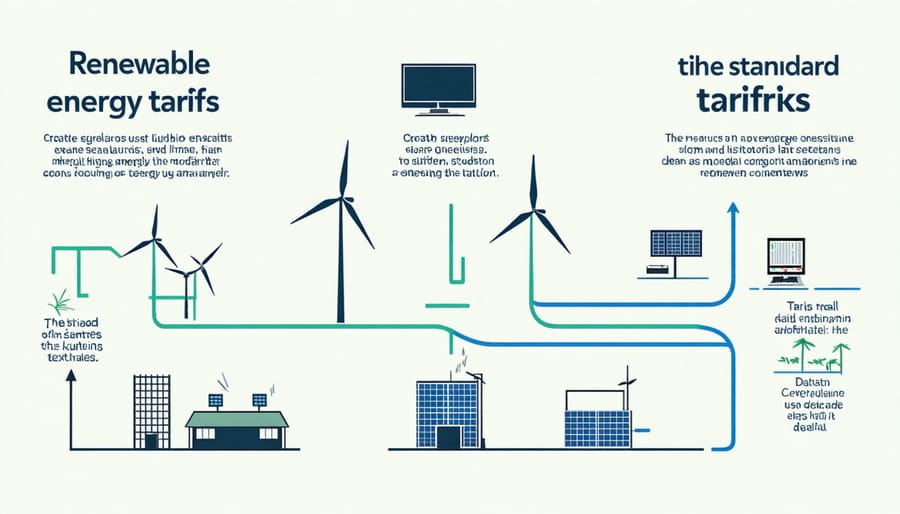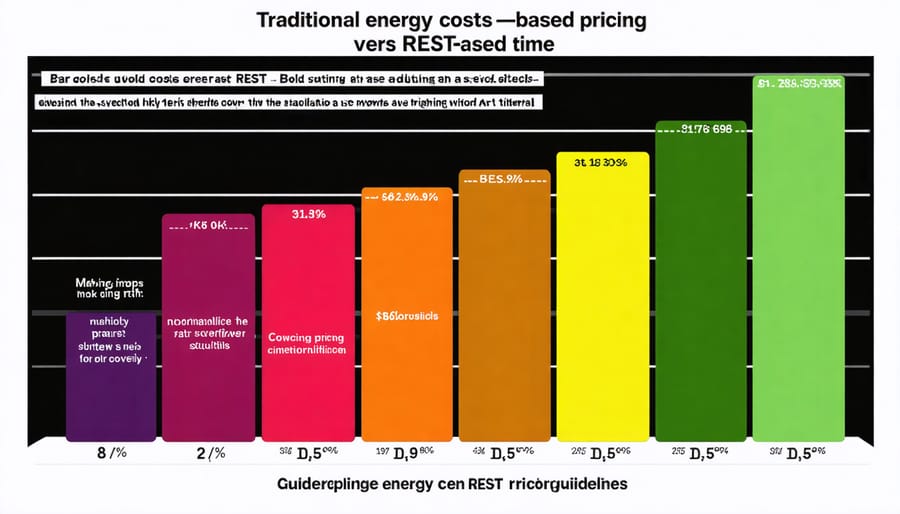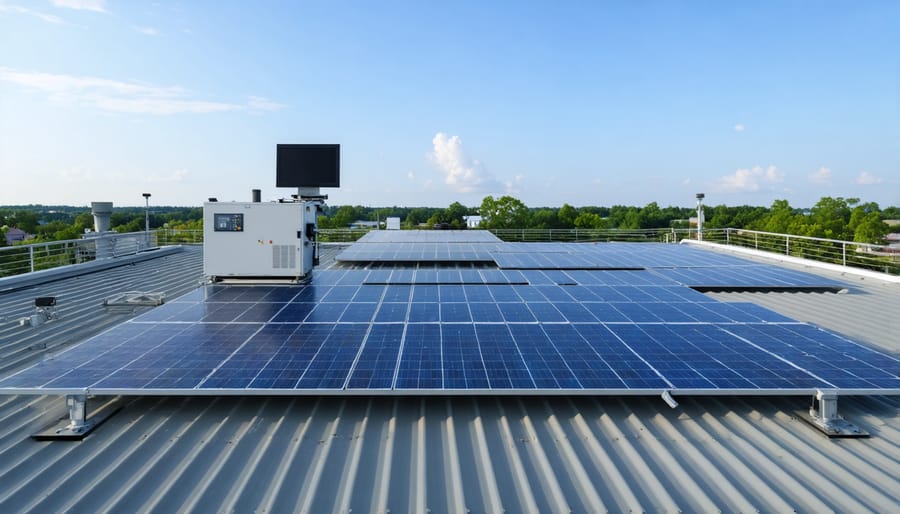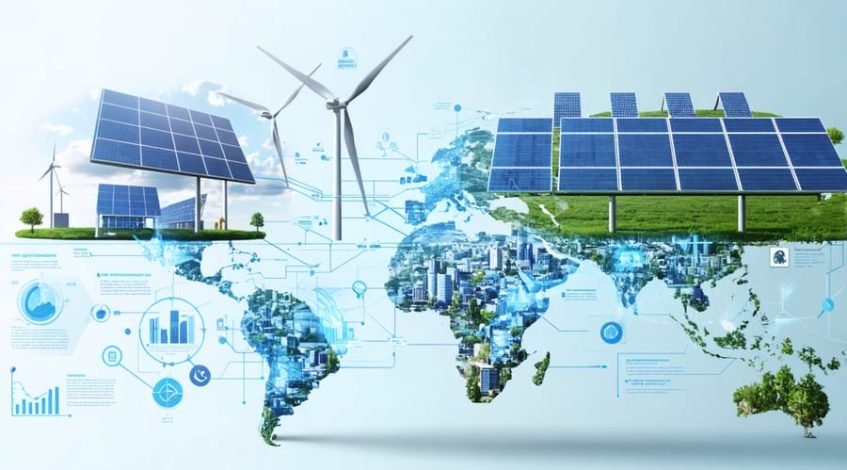Renewable Energy Standard Tariffs (REST) are transforming how businesses purchase and consume clean energy, offering a predictable pricing structure that’s revolutionizing the commercial power market. As decentralized energy grids become increasingly prevalent, these tariffs provide organizations with a strategic advantage in managing long-term energy costs while supporting sustainability goals.
Through REST agreements, businesses can lock in fixed electricity rates from renewable sources, typically wind and solar, for periods ranging from 10 to 20 years. This innovative pricing model eliminates the volatility associated with traditional energy markets while ensuring a reliable supply of clean power. For facility managers and corporate decision-makers, REST represents a crucial tool in achieving both environmental targets and financial objectives.
The growing adoption of REST across industries signals a fundamental shift in how organizations approach energy procurement. By combining the environmental benefits of renewable energy with the financial predictability of standardized pricing, REST offers a compelling solution for businesses seeking to optimize their energy strategy while maintaining competitive advantage in an increasingly sustainability-focused marketplace.
Understanding Renewable Energy Standard Tariffs
Core Components of REST
Renewable energy standard tariffs consist of several essential components that work together to create an effective pricing structure. The fixed rate component establishes a predetermined price per kilowatt-hour that utilities pay for renewable energy, typically guaranteed for 15-20 years. This long-term price stability helps developers secure project financing and provides predictable revenue streams.
The eligibility criteria define which renewable energy technologies qualify for the tariff, commonly including solar, wind, biomass, and small hydroelectric facilities. Project size limitations are typically specified, ranging from small-scale installations to utility-scale developments, ensuring appropriate market participation.
The interconnection requirements outline technical specifications for connecting renewable energy systems to the grid, including safety standards and equipment specifications. Contract duration terms specify the length of the power purchase agreement, while payment structures detail how and when generators receive compensation for their energy production.
Additional components include performance requirements, which establish minimum operational standards, and capacity allocation mechanisms that determine how utilities distribute available program capacity among participating generators. These elements create a comprehensive framework that promotes renewable energy development while maintaining grid reliability and economic feasibility.

How REST Differs from Traditional Tariffs
Renewable Energy Standard Tariffs (REST) represent a significant departure from traditional utility rate structures in several key aspects. While conventional tariffs typically feature fixed rates or time-of-use pricing based on overall energy consumption, REST programs establish specific rates for renewable energy generation and consumption. This fundamental difference enables businesses to better predict and manage their energy costs while supporting clean energy development.
Unlike traditional tariffs, REST programs often include long-term price stability mechanisms, protecting consumers from fossil fuel price volatility. These programs typically offer fixed rates for 15-20 years, whereas conventional tariffs are subject to regular adjustments based on market conditions and fuel costs. Additionally, REST structures frequently incorporate performance-based incentives that reward efficient energy production and consumption patterns.
Another distinguishing feature is the transparency in pricing. REST programs clearly separate renewable energy costs from other utility charges, allowing organizations to accurately track their green energy investments. This differs from traditional tariffs, which often bundle various charges together. The structure also typically includes provisions for excess generation credits, enabling businesses to benefit from overproduction in ways that conventional tariffs don’t accommodate.
Benefits for Commercial Solar Adopters

Financial Advantages
Renewable energy standard tariffs offer substantial financial advantages for businesses implementing commercial solar power systems and other renewable energy solutions. The primary benefit is predictable, long-term cost savings through fixed-rate energy pricing, typically locked in for 10-20 years. This stability protects organizations from volatile energy market fluctuations and rising utility costs.
Analysis of implemented REST programs shows that businesses can achieve ROI within 5-7 years, with energy cost reductions of 20-30% compared to conventional utility rates. These savings are particularly significant for energy-intensive industries, where electricity costs represent a substantial portion of operational expenses.
Additional financial benefits include reduced peak demand charges, as REST agreements often incorporate time-of-use pricing structures that incentivize optimal energy consumption patterns. Organizations can also benefit from various tax incentives, accelerated depreciation, and renewable energy credits, further improving the financial proposition.
Many businesses report improved budgeting accuracy and enhanced financial planning capabilities due to the predictable nature of REST pricing. This certainty allows for better allocation of resources and long-term investment strategies. Furthermore, organizations with sustainability commitments find that REST agreements help meet environmental goals while maintaining positive financial performance, creating a win-win scenario for both operational efficiency and corporate responsibility.
Long-term Business Benefits
Implementing a renewable energy standard tariff offers substantial long-term advantages that extend beyond immediate cost savings. Organizations that adopt REST position themselves strategically in an increasingly sustainability-focused market environment. By securing predictable energy rates through long-term agreements, businesses can better forecast operational expenses and protect themselves against volatile traditional energy prices.
Companies leveraging REST demonstrate environmental leadership, enhancing their brand reputation and attracting environmentally conscious customers and investors. This commitment to renewable energy often leads to improved Environmental, Social, and Governance (ESG) scores, which can translate into better financing terms and increased shareholder value.
The adoption of REST also provides a competitive edge in markets where customers and supply chain partners prioritize environmental responsibility. Many large corporations now require their suppliers to meet specific sustainability targets, making REST participation a valuable credential for business relationships.
From a risk management perspective, REST helps organizations navigate emerging carbon regulations and potential carbon pricing mechanisms. As governments worldwide implement stricter environmental policies, businesses with established renewable energy procurement strategies through REST are better positioned to adapt to regulatory changes.
Additionally, REST agreements often include provisions for technology upgrades and efficiency improvements, ensuring that participating organizations benefit from advancing renewable energy technologies without requiring additional capital investment. This future-proofing aspect helps maintain long-term cost competitiveness while supporting continuous environmental performance improvement.
Implementation Strategies
Assessment and Planning
Implementing a renewable energy standard tariff requires careful assessment and strategic planning to ensure optimal outcomes. Begin by conducting a comprehensive energy audit to establish your current consumption patterns and identify potential areas for renewable energy integration. This baseline assessment should include detailed analysis of peak usage periods, seasonal variations, and overall energy costs.
Next, evaluate your facility’s technical potential for renewable energy adoption. Consider factors such as available roof or land space for solar installations, wind resource availability, and grid interconnection capabilities. Engage qualified energy consultants to perform feasibility studies and provide detailed recommendations based on your specific circumstances.
Financial modeling is crucial for REST implementation. Develop detailed cost-benefit analyses that account for initial investment, projected energy savings, maintenance costs, and available incentives. Include sensitivity analyses to account for varying energy prices and consumption patterns over the agreement period.
Create a detailed implementation timeline that includes key milestones such as permitting, equipment procurement, installation, and system commissioning. Consider potential disruptions to operations and plan accordingly. Establish clear communication channels with utility providers and relevant stakeholders to ensure smooth coordination throughout the process.
Finally, develop monitoring and verification protocols to track performance and ensure compliance with REST requirements. Include regular maintenance schedules and establish clear procedures for addressing any issues that may arise during operation.
Integration with Existing Systems
Integrating renewable energy standard tariffs into existing power systems requires careful planning and coordination with current infrastructure. The process typically begins with a comprehensive assessment of the facility’s current energy consumption patterns and existing electrical systems. This evaluation helps determine the necessary modifications to accommodate renewable energy sources while maintaining system reliability.
For successful integration with modern energy infrastructure, organizations must implement advanced metering systems capable of tracking both consumption and generation in real-time. These smart meters enable accurate billing and monitoring under the new tariff structure while providing valuable data for optimization.
Key technical considerations include:
– Grid connection requirements and capacity
– Power quality management systems
– Energy storage integration capabilities
– Control systems and automation
– Safety mechanisms and protection devices
The integration process typically involves:
1. System compatibility assessment
2. Hardware upgrades and installations
3. Software and control system implementation
4. Testing and commissioning
5. Staff training and documentation
Organizations should work closely with utility providers and qualified engineers to ensure seamless integration while maintaining compliance with local regulations and industry standards. This collaborative approach helps minimize disruption to existing operations while maximizing the benefits of renewable energy standard tariffs.

Case Study: REST Success Story
The success of REST implementation is clearly demonstrated by the Montgomery Business Center (MBC) in Arizona, which adopted the program in 2019. This 500,000-square-foot commercial complex, housing over 50 businesses, showcases how strategic renewable energy integration can deliver substantial cost savings while supporting sustainability goals.
Before implementing REST, MBC’s annual energy costs exceeded $1.2 million, with significant monthly fluctuations affecting tenants’ operating expenses. The facility management team partnered with their local utility provider to develop a customized REST agreement that included on-site solar installation and predetermined rate structures for a 15-year term.
The results have been remarkable. Within the first year, MBC achieved:
– 35% reduction in overall energy costs
– Stabilized monthly energy expenses for tenants
– 2.8-megawatt solar installation providing 60% of the facility’s power needs
– Enhanced predictability in long-term operational costs
– Improved tenant satisfaction and retention rates
The project’s initial investment of $4.2 million was offset by federal tax incentives and state-level grants, resulting in a projected ROI period of 6.5 years. The stable pricing structure has allowed tenants to better forecast their operating expenses, leading to improved business planning and budgeting processes.
What makes MBC’s implementation particularly noteworthy is their phased approach to adoption. They began with a pilot program covering 30% of the facility before expanding to full implementation, allowing for careful monitoring and adjustment of the system. This methodical strategy has become a model for other commercial properties considering REST adoption.
The success at MBC has inspired similar implementations across the region, with twelve other commercial facilities following their framework within the past two years. Their experience demonstrates that REST can be successfully implemented in large commercial settings while delivering measurable financial and environmental benefits.
Renewable Energy Standard Tariffs represent a pivotal mechanism in advancing the adoption of clean energy solutions while providing businesses with predictable energy costs and environmental benefits. As demonstrated throughout this analysis, REST programs offer multiple advantages, including long-term price stability, reduced carbon footprint, and enhanced corporate sustainability credentials.
The future outlook for REST programs appears increasingly promising, with more utilities and regulatory bodies embracing these tariff structures. Market trends indicate growing demand from commercial and industrial customers seeking renewable energy options, driving utilities to expand their REST offerings. This expansion is expected to continue as technology costs decrease and grid integration capabilities improve.
For businesses considering REST participation, the time to act is now. Early adopters often secure the most favorable rates and terms, while gaining valuable experience in renewable energy procurement. The success stories from various industries demonstrate that REST programs can deliver both environmental and financial benefits when properly implemented.
Looking ahead, we can expect to see more sophisticated REST models emerging, potentially incorporating energy storage solutions and demand response capabilities. These innovations will further enhance the value proposition for participating organizations while supporting grid reliability and renewable energy integration.
As the energy landscape continues to evolve, REST programs will play an increasingly important role in facilitating the transition to a sustainable energy future while providing businesses with competitive advantages in an increasingly carbon-conscious marketplace.

